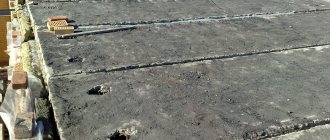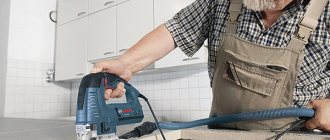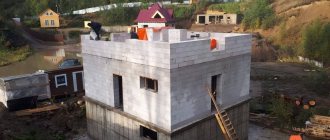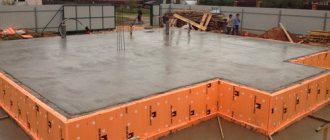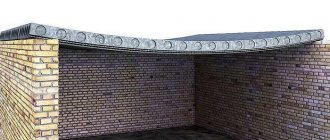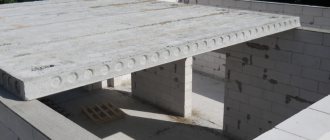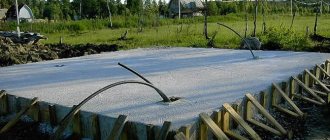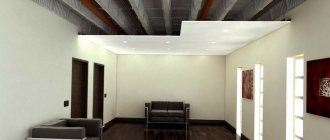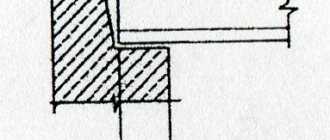Road laying technology
The construction of slab roads is a simple technological process that consists of a number of stages:
- laying requires a flat surface, for which, as a rule, the top layer of soil is cut off;
- to ensure the outflow of rain, as well as melt and groundwater, a small trench is dug on the surface, 25 - 50 cm deep;
- in order to prevent the destruction of the road due to washing out, as well as the appearance of unwanted plants, the laying surface is covered with a geotextile-based fabric;
- a cushion is formed on the prepared surface, 20-25 cm wide, consisting of crushed stone and sand, which is well wetted with water and compacted before laying the slabs;
- To lay the slabs evenly, a guide line in the form of a stretched cord is used. Reinforced concrete products are laid sequentially using a crane. The work is carried out by one team of workers with a crane operator and a slinger who hooks the slabs to the mounting loops;
- finished slabs can be compacted when adjusted manually using bench tools;
- in order to ensure the immobility of reinforced concrete products in a fixed position, side mounting loops can be used to connect elements to each other using steel rods and electric welding.
What to consider when installing?
Laying of road slabs is carried out using grabs with special booms. The plate is grabbed and placed in place. After this, preparation is carried out along the seam line.
It is important for builders to follow the correct direction of installation. A simple method is used for this - a cord is pulled along the installation level of the first line of slabs. The laying is carried out both closely and with a gap. It is important to secure the seams using technology - then the slabs will remain in the desired position.
Benefits of technology
- The method of building roads from slabs has a number of undeniable advantages, including:
- high speed of laying the canvas, which is the surface of finished reinforced concrete products;
- the strength and reliability of the coating, the production of which is carried out in the factory;
- extremely high service life, which is due to the quality of manufacturing of reinforced concrete products;
- ease of installation, for which crane equipment is used;
- reduced requirements for preparing the base for reinforced concrete products;
- versatility of technology. The road surface, made of slabs based on reinforced concrete, is not demanding on climatic conditions and can be used without destruction in the temperature range from -50 to + 55 degrees;
- the possibility of dismantling temporary roads, as well as unused road surfaces, with the possibility of reusing reinforced concrete products that have not exhausted their strength life.
What are the advantages of using road slabs?
- In a short period of time, temporary access routes can be laid using road slabs. This is relevant if you need to build a temporary road to a remote sparsely populated area when the road is washed out due to weather conditions.
- Thanks to the high density of road slabs, military equipment and large heavy vehicles can move smoothly without damaging the road.
- Delivery of road slabs can be carried out by rail using container transportation.
- It will take a minimum of time to lay a road surface from reinforced concrete road slabs. To install them, it is necessary to create a sand cushion on the ground. A road with such a surface can be used immediately after laying the slabs.
Manufacturing of reinforced concrete slabs
In the production of products in order to increase their strength, reliability and durability, reinforcement cages are used in the form of stressed (based on At-5, At-4 and A5 reinforcement), as well as non-stressed ones, made of BP-1 wire, A3, A1 or A3C reinforcement , designs. The characteristics of the slabs depend on the strength and physical properties of the concrete used. In this regard, solutions with waterproof and frost resistance classes up to W2 and F150 are used. The weight of the finished slab can reach 5000 kg with length dimensions from 1.75 to 6 meters and width from 1.5 to 3.75 meters.
How can you tell if the installation went wrong?
If good pavers with special equipment worked, the road will be smooth, without elevation changes. The plate is fixed stably and no vibration is created when moving on it. It is more difficult to understand that mistakes were made. We recommend paying attention to factors such as:
- the slabs are laid unevenly along the seam - somewhere there is a larger gap, somewhere smaller;
- the road is uneven, there are raised areas or areas that are too deep;
- cracks appeared on the slab during installation;
- the seams are not secured.
Our advice is to carefully walk along the road after completing the work and assess its condition. Use instruments to determine the degree of surface evenness. It is better to make sure of high-quality work at the start than to waste time dismantling the coating and laying the slabs again.
Classification
The production of road reinforced concrete slabs is carried out in accordance with the regulatory requirements of the GOST 21924.0-84 standard, according to which the products are graded into three main categories:
- RDP are the most popular and widespread reinforced concrete slabs of a universal type, which are used when it is necessary to construct permanent and temporary roads with an average load level of no more than 6 tons per wheel. The products can be reused after dismantling. Their load capacity is 10 - 30 tons and depends on the brand of concrete used in the manufacture. Precast concrete products are designed for operation in severe frost conditions – down to – 50 °C;
- PDN – products made on the basis of reinforced concrete with a prestressed reinforcement structure. Having increased load characteristics, the dimensions of the reinforced concrete products are 6000 mm in length and 2000 mm in width with a weight of 4200 kg. Due to the strength of the body due to the rigidity of the reinforcement frame, the products are recommended for use in heaving and soft types of soil;
- PAG is the most durable type of airfield slabs. The average weight of a product unit is 5 tons. Precast concrete products are focused on the construction of roads for heavy types of transport, as well as the construction of runways for aviation (PAG-18, as well as PAG-14). Structurally, the elements can have a smooth or corrugated surface, providing different grip on vehicle wheels. In the production of products, concrete mortar with grades from M350 to M400 is used. The maximum load reaches 75 tons. The products can be used at temperatures down to -35 °C.
What slabs can be laid?
The product is selected for the task. The characteristics of concrete and slab thickness will differ for a park path and an airport runway, so the choice must be made responsibly. The material must meet the following requirements:
- thickness not less than 14 cm;
- the presence of a reinforcing frame;
- compliance with frost resistance, compressive strength and moisture resistance to the standards of the installation area.
You can mount options with a smooth or corrugated surface. The choice is made based on the area of application and the transport moving over the surface. For example, corrugated slabs are used to avoid ice build-up. They are suitable for installation on pedestrian areas.
Types of reinforced concrete slabs
Depending on the shape, finished products are divided into the following categories:
- rectangular - “P”;
- rectangular in shape with sides of a combined type - “PPB”;
- rectangular design with one combined side - “PB”;
- trapezoidal shape - “PT”;
- made in the form of a hexagonal structure - “ПШ”;
- hexagonal transverse axial - “PShP”;
- hexagonal diagonal-axial products “PShD”;
- half transverse design of a hexagonal plate - “PPSh”;
- half diagonal hexagonal plate design - “DPSH”.
Road slabs are the best option for road construction when high laying speed is required and heavy vehicle traffic is expected. With their help, you can pave a road in the presence of difficult soil, as well as where they are needed urgently or temporarily. Many enterprises specializing in the production of reinforced concrete products are engaged in their production, especially since the technology does not require special equipment.
In the production of these products, predominantly heavy coarse-grained concrete is used , having a density of at least 2200 kg/m3 - no more than 2500 kg/m3, which gives it sufficient strength, durability, increased frost resistance, and resistance to cracking.
In addition to concrete, a reinforcing component is used in the production of slabs. Its strength characteristics significantly influence the magnitude of the maximum loads of the finished product. To increase the latter, prestressed reinforcement is used. To obtain pre-stressed concrete products, a reinforcing component of At-V, At-IV or A-V class is used. For non-tensioned products, a reinforcing component of rod type A-IIIC, A-III and A-I class or BP-I wire is used.
The manufacturing technology of road slabs is almost the same regardless of the type, with the exception of some nuances. To obtain the desired configuration of manufactured products, the appropriate form is used. The form must be cleaned of old concrete and then greased over the entire surface. Lubricant reduces adhesion to the metal, which means it makes removal easier.
Technological process for the production of slabs on thermo-vibration stands
Preparing stand forms for work
Clean the stand form from adhering concrete, cementite, and dust. Cleaning should be done using scrapers and metal brushes. Pay special attention to cleaning the horizontal surface of the mold (front surface). The sides, liners inside and outside, locks, and punches are also cleaned. Cleaning the mold with blows of a sledgehammer is strictly prohibited. The mold is lubricated both inside and outside with an emulsion based on EKS emulsol from a spray rod. Lubrication is carried out with the sides of the mold open. Apply the emulsion in a uniform layer 0.2 - 0.3 mm thick. without gaps or puddles. When lubricating molds, do not walk on lubricated surfaces. It is strictly unacceptable for grease to come into contact with fittings.
Preparing forms for reinforcement
The reinforcement tensioning station Hydraulic jack DAN-12/14 is brought to the cleaned and lubricated form of the stand. The end sides of the mold must be open so that the rods can be easily placed in the grooves of the temporary stops. The lower support grids are placed in the mold. In the process of tensioning and laying the rods, two molders with qualifications of at least 3 categories are involved. A reinforcing bar with collet grips is placed in a metal mold, and a tension jack is installed on the bar and tension is applied to a certain force, which is set at the jack's hydraulic station. When the force is achieved, the hydraulic cylinder rod returns back to release the valve from the hydraulic cylinder.
Measuring prestress in reinforcement
Control of the value of prestressing reinforcement is a mandatory component of quality control of prestressed reinforced concrete structures. The stress in the reinforcement is measured when the bars reach ambient temperature with the end sides of the mold open. Also, the rods should not touch the supporting lower grids. Measurements are taken at the middle of the stressed rod. After measuring the voltage of the reinforcement and receiving positive results, the controller gives a command to continue the technological process. The lower support grids are tied to the working rods with knitting wire.
Assembling the stand form
The sides are closed using a mounting crowbar; first longitudinal, and then end. The side locks must be fully tightened. After assembly, the tightness of the junction of the sides to the pallet, as well as to each other, is checked. The shape must meet the requirements of rigidity and deformability. If necessary, measurements of the molded product are made using a tape measure. To prevent concrete from flowing out through unused slots for reinforcement in the end boards, as well as the gaps between the mold tray and the rod, must be sealed (with tow, felt, rags, etc., etc.).
Molding
The concrete mixture must be prepared with an approximate depth of 0.5-1 cm and laid no later than 30 minutes from the moment of production. Concrete is placed evenly into the metal mold of the stand and distributed along the entire perimeter of the mold. Installation of frames, nets, mounting loops should be carried out in accordance with the working drawings. The supporting frames are fastened using a knitting wire to the upper mesh. The concrete of the top layer is evenly distributed over the surface and compacted while the vibratory blocks of the stand are operating for 8-10 minutes. The upper surface is leveled using a vibrating screed or as a rule within 1 minute with the vibrating blocks turned on. After a complete stop in the operation of the thermo-vibration stand, excess and sagging concrete is removed from the sides of the mold.
Heat treatment
- Keep the products in the mold until steam/water is turned on for 2 hours.
- Temperature rises to 80-85 degrees. The rate of temperature rise is no more than 20 degrees per hour.
- Isotherm at a temperature of 80 degrees for 8 hours.
- Cooling to 40 degrees for 2 hours.
Transfer of compression force to concrete (cutting)
All sides are opened and the rods are cleared of floating concrete. The cutting of the rods is carried out only after determining the transfer strength of the concrete of the product. The strength must be at least 70% of the design strength. Cutting is carried out with friction saws, oxy-fuel cutting, and also with an electric arc. The cut should be made at a distance of no more than 10 mm from the concrete surface of the product. The ends of the prestressing reinforcement protruding beyond the end surfaces of the slab must be protected with a layer of cement-sand mortar or bitumen varnish.
Stripping
The product, hooked to all mounting loops, raised to a height of 1500-1700 mm, is inspected for compliance with the category of the front surface, and only after inspection is transported to the storage area. Storage is carried out on rectangular wooden pads with a thickness of at least 30 mm near the mounting loops, perpendicular to the slab laid below. The length of the spacers should be 50-60 mm longer than the width of the slab. Mandatory presence when inspecting the slab during formwork; a master responsible for the quality of products or an inspector. In their absence, the inspection is carried out by the person responsible for stripping and subsequently reports to the foreman about any inconsistencies noticed.
Product repair, quality control inspection
Acceptance of products is carried out in the storage area by a quality control inspector in the obligatory presence of a foreman or foreman. The appearance, geometric dimensions, and strength characteristics are examined. If during stripping the front surface was not inspected, the product must be lifted using an overhead crane and inspected. The decision on the technology for repairing a product is made by the foreman together with the inspector, and, if necessary, the technologist. Repairs are carried out during the work shift after a decision is made about its necessity. Defects in the front and side concrete surfaces are repaired with a cement-sand mortar of at least grade -100. The upper concrete surface is repaired with concrete one grade higher than the concrete grade of the product being repaired. Acceptance of quality control departments and repaired products is carried out after 24 hours of their presence in the workshop at a temperature not lower than + 20 degrees C.
